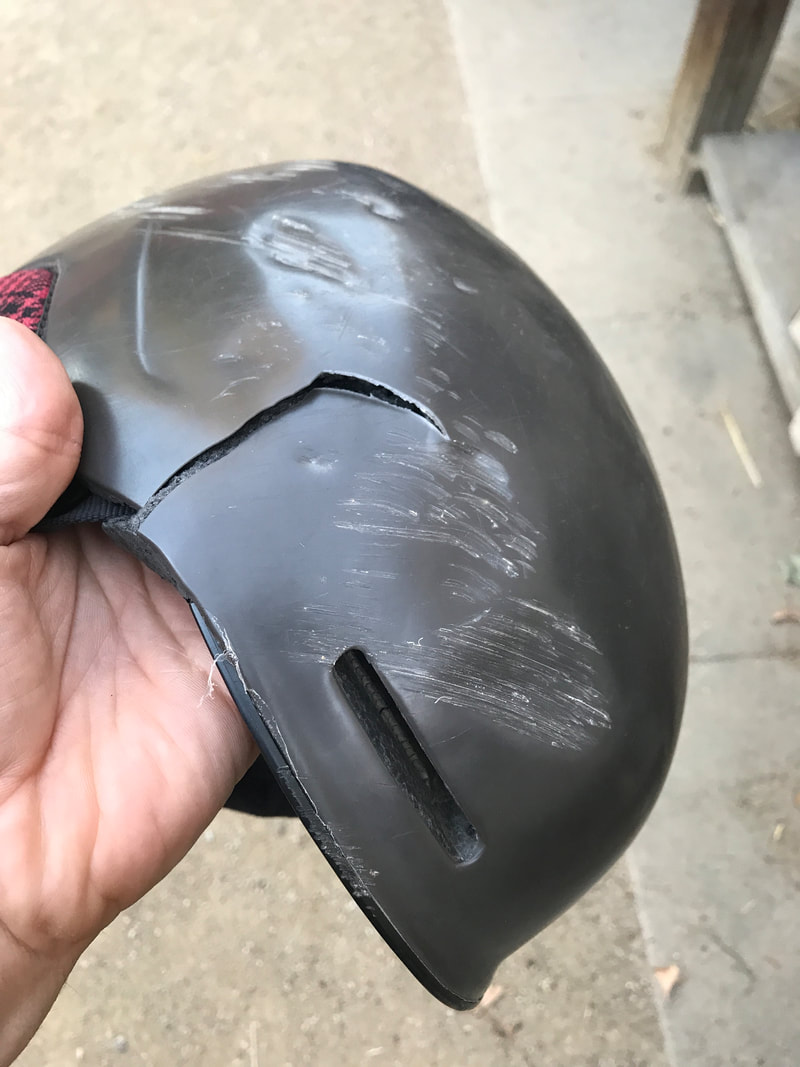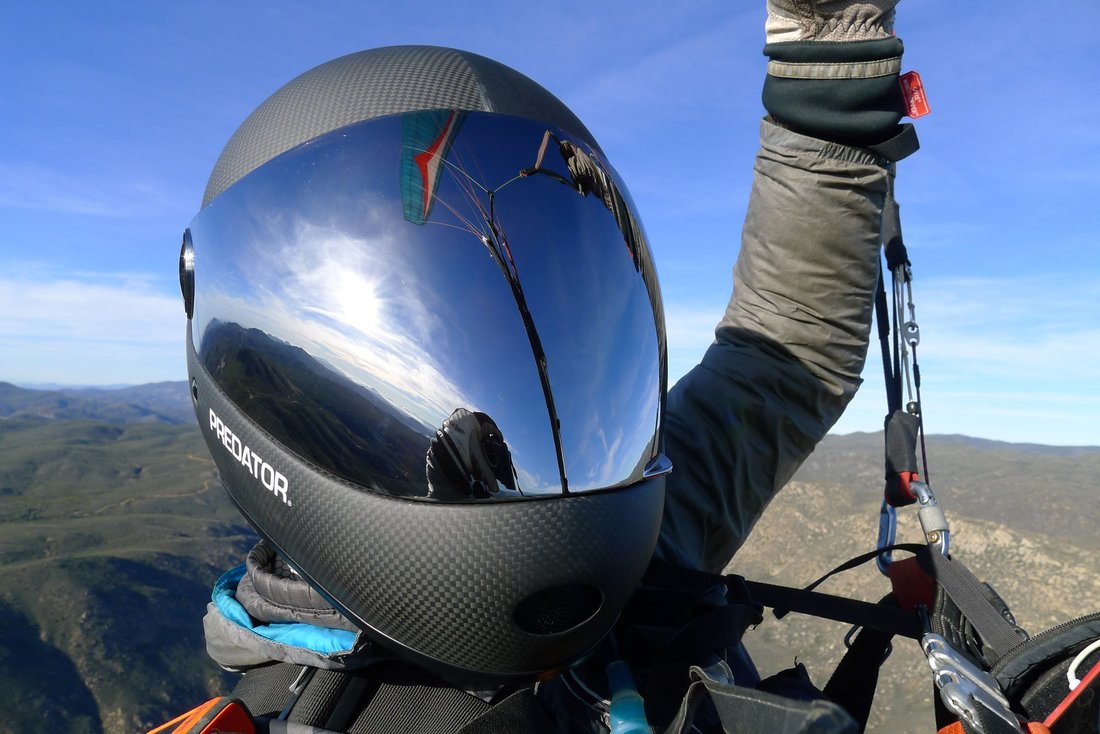| There’s nothing like being in the market for a helmet to have everyone you meet mention, “Well, when you buy one, let me know what you got.” I got into the market after slamming into a mountain and cracking my helmet in the crash. Cracking a modern helmet is not easy, and it made picking out my second helmet a far more serious affair than when I bought my first. |
I also classified crashes into 2 types: Ones that kill you, and ones you walk away from. I figured you'd either be dead or walking away, and what type of helmet you wore wouldn't make a difference as long as you wore *something*.
With a more nuanced understanding after 3 crashes in about 8 months that I walked (or limped) away from, I now think helmet selection has a good amount of impact (no pun intended) on what condition you're in when you do get to walk away.
With the recent realization that I am not, in fact, invincible, and, like everyone else, my brain responds negatively to high impacts, I wanted the best protection around.
I was guided towards checking out MIPS technology, which is “sliding plane technology” that has basically taken over the high end biking helmet world, and for good measure I took a look at the latest and greatest in football helmet technology. I also read through a ton of forums (more links below) where it became clear that many paragliders are dissatisfied with current free flight helmet options.
BLUF: I got a Predator DH6X, which is a carbon fiber* helmet with visor that is made for downhill skateboarding. That doesn't mean you should buy one, it's just what I decided to get. Read on for a quick primer on making helmet decisions.
A few companies sprang up to fill the niche for downhill (and electric?!) skateboarders. I brought it back full circle and jumped on board with the newest helmet tech I could find, which came from downhill skating, a sport that shared many of my helmet requirements: Excellent protection, smooth exterior surfaces, light weight, full visor, limited ventilation.
Along the way to buying that (US $470 shipped), I educated myself enough on helmets to give you some good guidelines when it comes time to replace your own skull-saver.
The good news? For under $300, you can get a REALLY good helmet. It'll be about 40 grams heavier than mine. :)
Before I get to that, let’s talk about the elephant in the room.
Open face vs full face
Yes, I know you have an opinion on this. I have yet to talk to a pilot who is not absolutely sure one way or the other.
In this case, set your opinion aside for a moment and check out the stats from 453 cases of motorcyclists who sought emergency care treatment due to head injuries.
Yes, I’m aware that motorcycles are different than paragliders.
Here are the three important pieces of information:
Number one, wear a helmet. That basically quarters your chance of injury.
Number two, fasten your helmet securely. Compared with motorcyclists with firmly fastened helmets, those with loosely fastened helmets increased their risk of head injury and were more than twice as likely to have brain injuries.
Number three, if you want the best possible protection, wear a full face helmet. Compared to full face helmets, those wearing half-coverage helmets were more than twice as likely to have brain injuries or head injuries.
Yep, you read that right.
Not convinced because you heard of someone snapping their neck due to a full face helmet?
The studies (yes, more than one of them) show that full face helmets prevent more injuries than open face.
Still, there is good news for you open facers. Not all research agreed with this outcome, and one motorcycle study showed there was no difference in the Facial Injury Severity Scale (FISS) between open face and no helmets. This may be due to riders on different bikes (sport vs cruiser) going different speeds and taking different risks. In addition, that is referring to *facial* injury severity, not snapping necks, which is a common concern in many helmet-wearing communities.
Obviously, you can do what you want.
I bought a full face helmet with visor and a decent thickness of foam, including an EPP liner that spreads the impact out, EPS foam that absorbs as much as possible, and EVA spongy fit pads to make it comfy.
For a full article on liner materials, go here.
As a quick aside, there is also discussion and disagreement on facial protection, i.e. visors, chinguards and "other". As far as the "other", Ruroc makes some of the coolest looking helmets available, and they appear to have facial protection, but once I read more about what that protection was, I figured it wasn't enough for what I wanted.
Next up, what else should you look for in a helmet? I’ll break it into two categories. Certifications and weight.
Certifications
Ground rules: All helmets must have some certification. Even if you could find one, you shouldn’t buy an uncertified helmet.
There are three main bodies that certify the helmets we pilots fly with:
The European Committee for Standardization (CE EN)
The American Society of Testing Materials (ASTM)
The Consumer Product Safety Commission (CPSC)
There are impact tests, penetration tests, roll-off tests, differently shaped anvils that the helmets are smashed into, cones, points, and other elements of helmet destruction that are used. Get lost in ‘em. I did for a bit, then surfaced and looked for the basics.
Up until 2014, the FAI only wanted us pilots to use EN 966 certified helmets, but in May of 2014 they decided to open it up to snow and ski helmets in order to give us fliers more access to current technology.
If you want to compete in FAI sanctioned “1st category” events, you’ll need a helmet certified to EN 966, which specifically targets “airports” helmets, or ASTM2040 (snow sports), or SNELL rs98 (ski & snow helmets.) Hang gliders can also use EN1077 A & B, although from the forums I read, the 1077B is probably the least protective.
EN 966 tests for shock absorption, penetration, and retention system strength & effectiveness.
The first helmet I had (that Smith Maze you saw above with the huge crack in it) has an ASTM F 2040 certification (snow sports) and an EN 1077B, which is the lower of the two 1077 certs.
The helmet I just bought, the Predator DH6X, does not pass EN 966 certification because the retention system isn’t an easy thing to open and increases risk of strangulation. I decided that was an acceptable risk, but Matt at Predator has said if he can get 15 pilots together on a group buy he’ll switch out the straps to be 966 approved.
If you’re not worried about competing and you’re psyched on a bike helmet, you’ll want to look for EN 1078 or ASTM F1952 certifications.
If you want to dive deeper into helmets for pilots, the hang gliding forums have several excellent discussions, here and here (in particular they bash Charlys), and then this article in XC mag from 1999.
Until I found the Predator, I was leaning towards this downhill mountain bike helmet because they were relatively lightweight and seemed to be leading the helmet tech charge, but downhill mountain bike helmets in general had two problems. One, they had too much ventilation for my liking, and two, none of them was a particularly comfortable fit for me.
For you San Diego pilots who want to try on a good selection of full face downhill mountain bike helmets, check out Bike Bling up in Escondido (shout out to Tony Boyer for pointing me their way.)
Finally, if you (as I did) want to know why many helmets have only one or two certifications, keep in mind that each certification costs the company about $5k plus all the helmets they have to provide that’ll be destroyed. For many small companies, it doesn’t make sense to get EN 966 when their main market is somewhere else.
I decided that for me, I’d be fine with any of the following: EN 966, ASTM F1952, EN 1077A, CPSC, (all mentioned already) or EN 1078, which is the European certification for pedal cyclists, skateboarders, and roller skaters. While they all have slightly different tests they have to pass, they’re all within the realm of what I was comfortable with when it comes to protecting my head.
Weight
Look at the weight of your helmet. For you pencil necks you’ll want it lighter, say 4-600 grams. I don’t think that light weight is worth the risk of decreased padding and protection, but I know some of you cut your toothbrushes in half to safe a few grams. Keep in mind that it’s your head you’re protecting. I consider the condition of my head and face pretty important.
For those of us who occasionally enjoy lifting heavy things (like our meat-filled heads), anything under 800 grams is fine. As a comparison, the lightest motorcycle full-face helmets on the market run around 1,500 grams.
Hey, hey, what about MIPS?
MIPS was where I started my helmet quest, as it’s certainly among the latest tech to be marketed.
MIPS is basically an extra low-friction shell in your helmet that allows your head to slide around a bit inside the helmet, reducing rotational forces on impact which are linked to brain injuries. As I got deeper into it, I came to the conclusion that MIPS is closer to excellent marketing than a drastic improvement in helmet protection, although I’m sure it may help. Here’s the article that got me thinking about it.
Here’s what the MIPS folks have to say. I don't MIPS will hurt you, and it'll *probably* help, but I stopped thinking of it as a requirement on my next helmet.
Ok, that’s the long & short of what I found. If you have a question you'll probably find the answer in one of the many links provided. If you still haven't found an answer, please comment below so that the whole community can learn from whatever the answer (or discussion) is. Thanks!
Here’s a list of helmets that you might check out if you’re in the market:
Further reading here:
Hang Gliding forum on bike helmets.
Oz Report, thoughts on helmets.
Davis Straub on Helmets (in depth with physics!)
Cheers,
Nik Hawks
05JAN2019 Update on Predator DH6X: Have now taken this helmet out for about 10 flights and am psyched on it. It does have a small wear point where the visor slides over the forehead of the helmet (consistent across all 3 helmets I've seen in San Diego) so if you're into cosmetics be aware that you'll have a "rub streak", which you can see in the photo I posted at the top of the article.
Being that this is my first helmet with a visor AND I don't have a ton of flights with it yet, I'm not sure I'll keep the visor on, although it is REALLY nice on cold days. Will probably remove it for summer flying.
*Helmets that are marketed as "carbon fiber" usually only have 1 or 2 thicknesses of carbon fiber, then the rest is fiberglass. I was learned about this from TJ Patrick, who works with carbon fiber for a living. This is due to the extraordinary cost of carbon fiber. A quick way to check if a helmet shell is made solely of carbon fiber is the cost. A true carbon fiber-only shell will run north of $2k, and the only ones I'm aware of are worn by F1 race car drivers, where cost is not really a consideration.





 RSS Feed
RSS Feed

